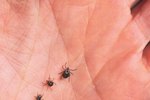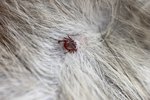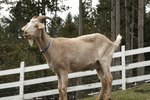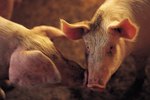Cattle may be affected by either sucking or biting lice. The former cause more damage to the animal, since a severe case of blood-sucking lice can lead to anemia and death. Sucking lice are more often around the head, while biting lice appear on other parts of body. Biting lice, which feed on skin, sores and blood, cause the animal more misery in the form of intense itching.
Tips
Lice are more likely to affect cattle in wintertime, when hair is thicker and there is less sunlight and rain -- nature's way of keeping lice numbers down. Biting lice are more likely to infest dairy cattle, while sucking lice more often appear on beef animals.
Signs of Lice in Cattle
Cattle harboring lice generally have a poor-quality coat. Other signs include:
- Constant itching
- Hair loss
- Greasy hair
- Lesions from secondary infections after the animal scratches open the skin.
You might notice damage to trees or fencing because the cattle are using these items as scratching posts to relieve themselves of the terrible itch.
Lice Eradication
Keeping your cattle healthy and in good weight can help prevent lice infestation. Using the pour-on version of ivermectin -- a common dewormer -- both eradicates lice and rids your cattle of most intestinal parasites. Pour-on insecticides containing pyrethroids will get rid of lice. Pour-ons are systemic, absorbed into the skin. For prevention, the dewormers and the insectides pour-ons must be applied in the fall, before the lice take hold in the cold.
Whatever method of lice control eradication you use, they won't kill the louse eggs stuck to the animal's hair shafts. You must repeat the delousing process about three weeks later to kill the newly matured lice.
Preventing Lice Infestation
Since lice spread via contact with an infested animal, quarantine all new cattle for at least a month and check them carefully for lice before introducing them into the herd. This quarantine is a good biosecurity measure for all types of bovine diseases and parasite infestation.
Natural Treatments
If you market your cattle or their milk as organic, you can't use pesticides to eradicate lice. Some of your options include:
- Diatomaceous earth: Use the food-grade version and apply it all over your cattle. Wear a mask when doing so. The tiny particles of diatomaceous earth pierce the lice exoskeletons, causing them to die.
- Frequent soaping: Regularly soaping, not bathing, your cattle with pure soap will get rid of lice, but you'll need to soap them often.
- Organic oils: Rubbing organic oils, such as canola or soy, on the affected areas will kill lice. Use a thin coat and repeat the process frequently.
Writer Bio
Jane Meggitt has been a writer for more than 20 years. In addition to reporting for a major newspaper chain, she has been published in "Horse News," "Suburban Classic," "Hoof Beats," "Equine Journal" and other publications. She has a Bachelor of Arts in English from New York University and an Associate of Arts from the American Academy of Dramatics Arts, New York City.





